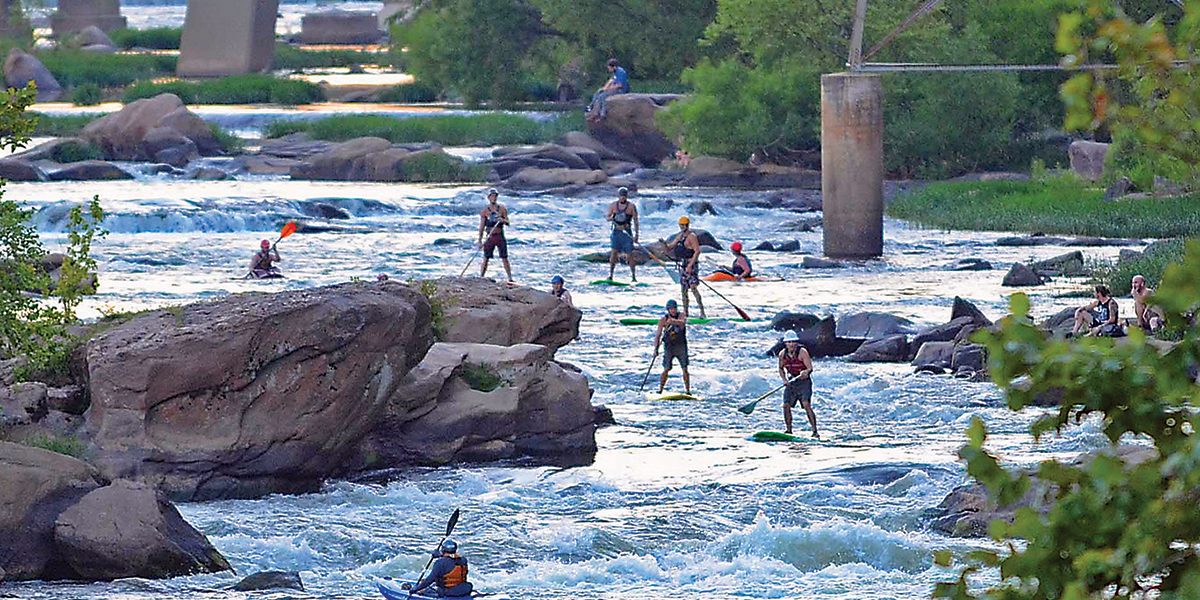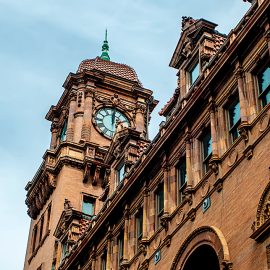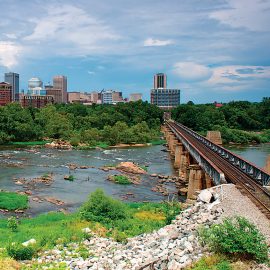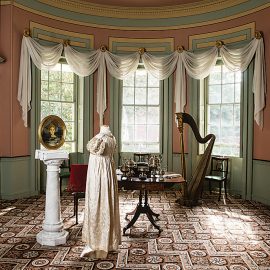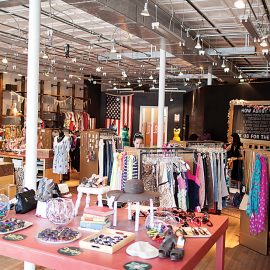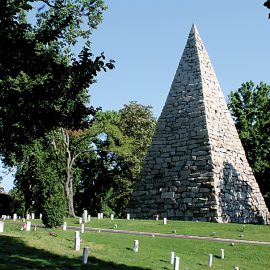Travel & Outdoors
Where History Meets Hip
Museums abound in Richmond, VA, as do great restaurants, shopping, and outdoor activities.
“All forward!” yelled Robby, our river guide. “Paddle hard!”
The four of us—my husband, me, and our two teen children—dug our paddles
into the churning James River as we had been taught. But it didn’t seem
to make any difference. We had turned sideways, and our rubber raft was
picking up speed as we headed toward a steep plunge. “Keep paddling,”
Robby commanded from the back of the boat as we dropped. A wall of water
washed over the front of the boat, drenching us. Then it was over. We
were on the other side of the famous “Pipeline,” the water once again
calm. The skyline of Richmond, VA, was ahead of us, dominated by the
sleek Federal Reserve Bank building. Along the shore, people were
throwing balls to dogs, splashing in the cool water, and sunning on
large, flat rocks.
Though Richmond is small, with a
population of just over 200,000 (about a third the size of Baltimore),
this capital city, college town, and former seat of the Confederacy is
far from sleepy.
In fact, it’s the only city in America with Class IV rapids
running through it. A great way to experience them is with a guided
rafting tour from Riverside Outfitters (6836 Old Westham Rd., riversideoutfitters.net), which also provides guided kayak trips, as well as rentals of kayaks, canoes, paddleboards, mountain bikes, and tubes.
Less than three hours from Baltimore, Richmond provides an
ideal long-weekend getaway filled with outdoor activities, shopping,
great restaurants, fun bars, fascinating museums, and, of course, plenty
of history.
Richmond is a city of contrasts—an outdoor mecca in the midst of
urban neighborhoods and a city that draws pride from its tragic past,
while also celebrating how far it has come.
The almost 150 years since the end of the Civil War seem like
an eye blink in Richmond. The city’s defining conflict is always
nearby—in museums, of course, but also in the larger-than-life statues
of Jefferson Davis, Stonewall Jackson, Robert E. Lee, and others lining
Monument Avenue, a wide, easy-to-drive, five-mile road through the heart
of town. Even change that seems like progress can open wounds. In 1996,
a statue of Richmond native Arthur Ashe was added to Monument Avenue
with much criticism from people who said the tennis great and
civil-rights activist shouldn’t share a street with Confederate War
heroes.
During our visit, we met Jay, who has lived in Richmond since
1989. He told me Confederate widows were still living in the Home for
Needy Confederate Women (now the site of offices and meeting rooms for
the Virginia Museum of Fine Arts) when he first moved there. Now, the
city is defined by activities and events like the Greek Festival, which
drew crowds during our visit, or the First Friday art walks amid the
galleries along Broad Street.
Talk to Richmonders for more than a few minutes, and you’ll
likely hear that the men’s basketball team of Virginia Commonwealth
University made the Final Four in 2011. That victory brought a jolt of
electricity to VCU, which enrolls more than 31,000 students and is known
for its engineering and arts programs that have energized the city.
A good starting point for a Richmond visit is the Valentine Richmond History Center (1015 E. Clay St., richmondhistorycenter.com),
located on a shady street among the buildings of the VCU Medical
Center. Sculptor Edward V. Valentine—the brother of Mann S. Valentine
Jr., who made his fortune selling a “Meat Juice” health tonic—opened the
museum in 1898 for his collection of art and artifacts.
Today, exhibits include a look at Richmond social events
through the years (check out the turn-of-the-century outfits),
photographs of Richmond, and a gallery of First Lady portraits. A
timeline on the floor, in the shape of a river, winds through several
rooms, highlighting the importance of the James River, which made this
inland city a significant port from its earliest days.
As the timeline so concisely explains, Richmond’s story begins in
1606, when Capt. John Smith set sail from England. Richmond became the
capitol of Virginia in 1780, though it wasn’t incorporated as a city
until two years later. While Union occupation of Richmond during the
Civil War is the city’s defining tragedy, there were at least two other
terrible events in its history. In 1811, a theater fire killed 70
people, including the newly inaugurated governor, George W. Smith. And
in 1870, a floor of the Capitol building collapsed, killing 50 instantly
and injuring more than 100.
The museum also houses an exhibit called “A History of Richmond
in 50 Objects,” which includes a fascinating 1955 travel video, the
suit L. Douglas Wilder wore to his inauguration as the state’s first
black governor in 1990, a gay-pride rainbow flag from 2011, and a
Confederate sword.
The Valentine Museum is on the same street as the The Museum of the Confederacy (1201 E. Clay St., moc.org), which is
actually two attractions: a modern, three-story museum attached to the
White House of the Confederacy, where Jefferson Davis lived during the
Civil War. For $15, visitors gain admission to the museum plus a guided
tour of the restored mansion, which is the only way they’re allowed to
experience it.
Allot an hour or more for the museum, which is filled with
exhibits detailing the history of the war, including major battles, what
life was like on the home front and in the camps, and the music that
soldiers played for entertainment. Uniforms, rifles, children’s dolls,
and maps are among the many display items. One particularly evocative
item is a field book, open to a hand-drawn map, with two bullet holes
through it.
After touring the museums, you’ll be hungry for lunch. Burger Bach (10 S. Thompson St., burgerbach.com),
a charming place with outdoor seating in nice weather, bills itself as a
“New Zealand-inspired gastro pub” and serves some of the best burgers
and fries I can remember, including a choice of homemade condiments like
fresh ketchup and tzatziki sauce. The menu features fries, salads, and
burgers made with beef, chicken, or (my recommendation) New Zealand
lamb.
For its size, Richmond has a wealth of restaurants in all price ranges and at all levels of formality. We went to Edo’s Squid (411 N. Harrison St.), a city institution near Monument Avenue, in a bustling part of the city known as The Fan.
The restaurant, up a narrow flight of stairs, feels like somebody’s
home, a small room crowded with happy people, alive with conversation
and the heady scent of garlic. The Italian dishes are mostly pasta,
meat, and seafood, including exquisitely tender fried calamari, a fat,
flaky rockfish, and perfectly al-dente pasta with a flavorful
red clam sauce. Even though we were full, we mananged to stuff in a few
bites of tiramisu, which was decadent in every direction—creamy,
espresso-y, boozy, and just plain delicious.
A classic Richmond eating experience is to dress up (though it’s not required) for afternoon tea or Sunday brunch and head to The Jefferson (101 W. Franklin St., jeffersonhotel.com), a lavish five-star hotel that opened in 1895. Its staircase is said to be the model for the one in Gone with the Wind, where Rhett carried Scarlett.
Another food stop is Coppola’s Deli (2900 W. Cary St., coppolasdeli.com),
which opened in 1982 and serves impressive subs, including an excellent
eggplant parm and a meat-filled extravaganza of its own invention known
as the Industrial.
The deli is located in Carytown (carytownrva.com),
a lively neighborhood with tree-lined streets, wide sidewalks, and
plenty of locally owned, even quirky, places to shop, eat, and drink. At
the consignment store Ashby (3010 W. Cary St., ashbynotes.com),
most items of clothing are $30 or less, and shoppers can bring in their
own items to sell for a store credit on future purchases. World of Mirth (3005 W. Cary St., worldofmirth.com)
is a mammoth, kid-friendly toy store. And if you’re in the mood for
something sweet, head to Dixie Donut, Carytown Cupcakes, or Bev’s Ice
Cream.
Not far from Carytown is the Virginia Museum of Fine Arts (200 N. Blvd., vmfa.state.va.us),
which is free to the public, except for special exhibits and programs.
It offers a sunlit and marble-cool sanctuary that is soothing to the
eyes and spirit. There are paintings by Dalí, Klee, and Kandinsky, plus
exhibits from all eras and corners of the globe, including 17th-century
European tapestries and artifacts from China. The Best Cafe is a good
place to go for affordable snacks and the opportunity to eat outdoors,
overlooking the sculpture garden. The Amuse Restaurant offers fine
dining with a lunch menu that includes pan-seared scallops and
pork-confit croquettes.
Closer to the river is the Hollywood Cemetery (412 S. Cherry St., hollywoodcemetery.org),
the final resting place of Presidents James Monroe and John Tyler as
well as Jefferson Davis, six Virginia governors, and more than 80,000
other souls. Guided tours are given April through October, but visitors
can also stroll the 135-acre site, which opened in 1849, without a
guide.
The cemetery is near the Tredegar Iron Works (500 Tredegar St., tredegar.org), an important contributor to Richmond and Civil War history. The site houses two museums: Richmond National Battlefield Park Visitor Center, which is open to the public at no charge, and the American Civil War Center, which costs $8 for general admission.
From the Iron Works, it’s a short walk across the James River on a pedestrian bridge to Belle Isle,
a 54-acre chunk of land that was once home to a notorious Civil War
prison camp, where more than 1,000 Union soldiers perished. The land use
is more positive these days. You’ll find runners and bicyclists
circling the island on a tree-shaded path, while kayaks, canoes, and
rafts meander by on the river.
History and recreation, splashed by the roaring James River. That’s Richmond.
